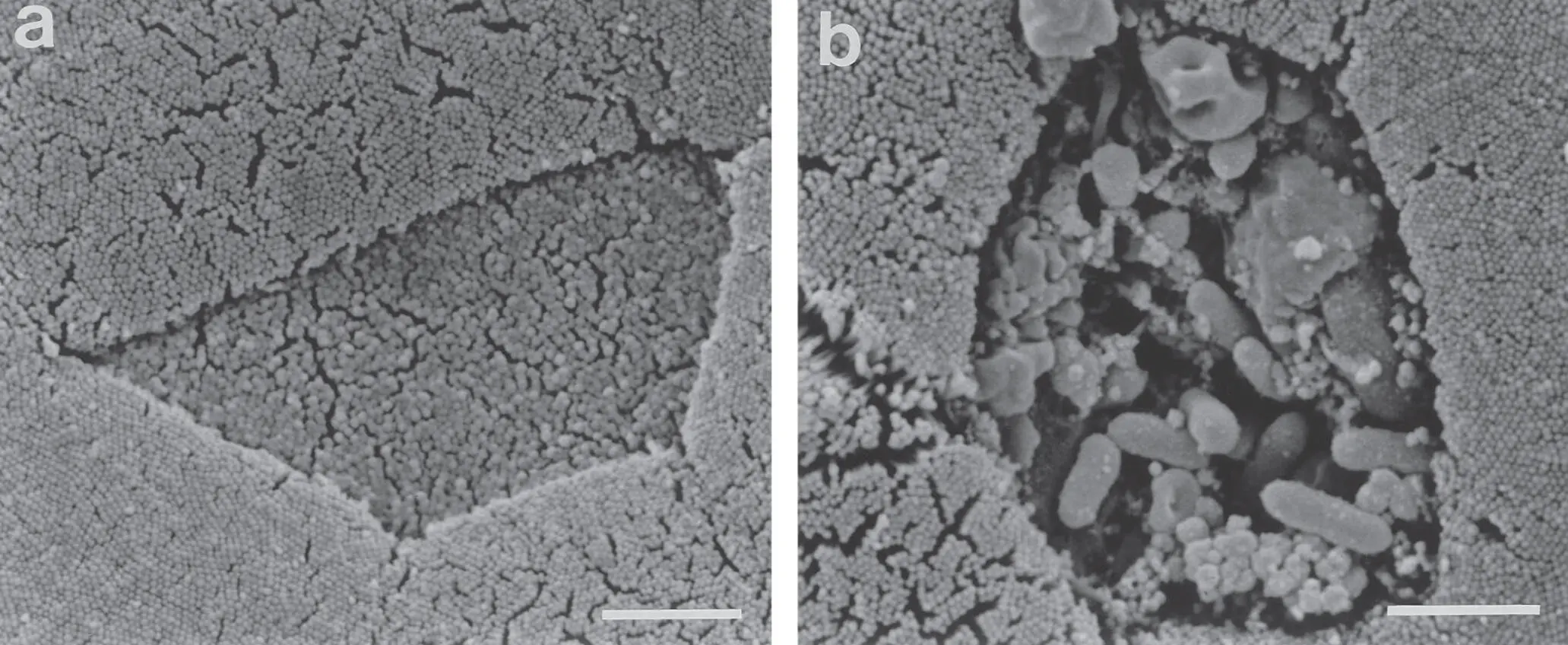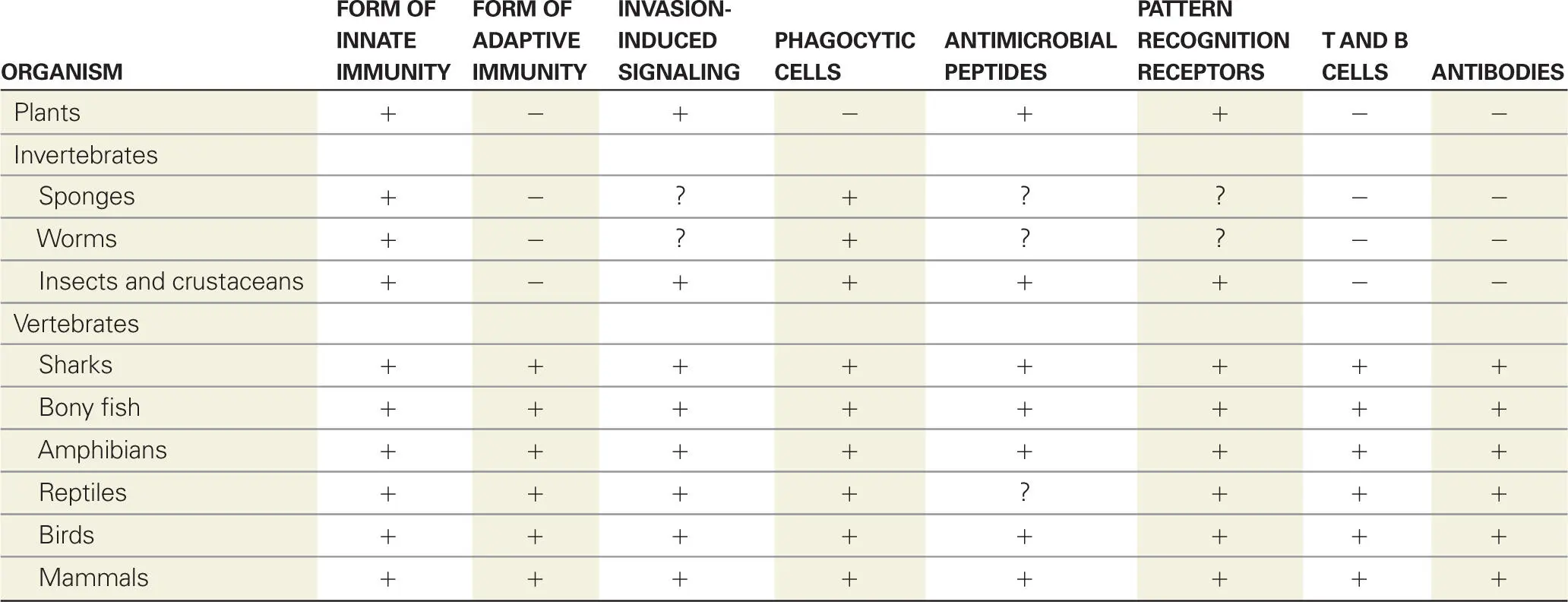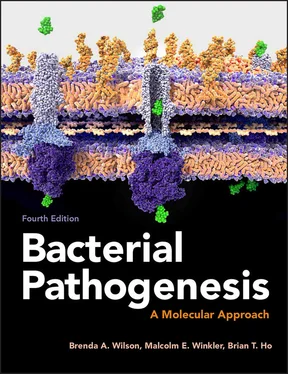
Figure 4-14. Scanning electron micrographs of mouse Peyer’s patches (a) before and (b) after incubation with Yersinia pseudotuberculosis. Both images depict a central M cell surrounded by enterocytes (and part of a brush cell in the lower left of panel b). The M cell in panel a lacks adherent bacteria but, in contrast, the association of bacteria with the M cell in panel b is accompanied by disruption of the normal surface morphology of the M cell. Bars, 2 µm. Reprinted with permission from Clark MA, Hirst BH, Jepson MA. 1998. Infect Immun 66:1237–1243.
Development of the Adaptive Immune System from Infancy to Adulthood
Human infants do not develop fully effective immune defenses until they are one to two years of age. Infants have very low levels of NK cells and are deficient in mannose-binding proteins, one of the acute-phase proteins produced by the liver that helps opsonize some types of microbes. For the period up to one year of age, maternal antibodies that were transferred through the placenta during gestation or ingested in milk during infancy protect the infants at least partially. The infant’s antibody production begins to kick in at about two to three months of age, but the rate of production is still relatively slow with antibodies being short-lived and of low avidity. T-cell-independent responses do not start until about 18 months of age. The transition between the protection conferred by maternal antibodies and the development of the infant’s own immune system provides pathogenic microbes with a window of opportunity and is one of the reasons why children under the age of two are particularly vulnerable to infectious diseases.
Interestingly, circulating maternal antibodies can actually interfere with an immune response to some antigens, because high levels of antibody to a particular epitope discourage the development of an antibody response to that epitope. This is a consequence of immune regulation that normally protects the body from overreacting to a particular epitope. The dampening effect of circulating maternal IgG is the reason why some vaccines are not given to infants less than one year of age.
Adaptive Defense Systems in Nonmammals
Scientists have found primitive versions of the mammalian adaptive defense system in many different organisms, ranging from insects to sharks ( Table 4-2). Insects such as Drosophila melanogaster (fruit fly) and slime molds such as Dictyostelium also have primitive defense systems that resemble mammalian defense responses, especially the innate immune response. Zebra fish not only have an innate immune response but also have a response that parallels the Th1/Th2 adaptive response. Sharks produce antibodies that can bind to human pathogens.
Table 4-2. Defense systems in higher organisms

Even plants have a primitive defense system in which proteins produced by the plant (R proteins) bind to invading bacteria, a reaction that produces apoptosis in the surrounding plant cells. This area of dead, dry tissue, which appears as black spots on leaves or fruit, traps the bacteria in the area. Bacteria need to move throughout the plant via the xylem and phloem in order to cause serious disease, and the plant’s defense response is designed to prevent this.
Assertions that systems in nonmammals are “immune systems” should be viewed with some skepticism. In the case of sharks, plants, and zebra fish, there is evidence that the systems are actually a response that protects the organism from infection. In the case of Drosophila, however, the Toll receptors that led to the discovery of mammalian Toll-like receptors, which are a central part of the mammalian innate immune response, appear to be involved primarily in development of the insect or in feeding behavior. Only one Toll receptor appears to play a role in defending the insect against fungal infections. Nonetheless, it is intriguing to see that parallels of what we know as the mammalian innate and adaptive defense systems are so widespread in other creatures. Interest in the evolution of the mammalian immune system is a relatively new area of research focus, so there are likely to be many more insights in the future as this research progresses.
The Dark Side of the Adaptive Defenses: Autoimmune Disease
Complex figures such as those shown in this chapter illustrate the manifold interactions that occur between cells of the immune system when they activate each other. All of those proteins labeled CD followed by a number have an important role. They help ascertain that the contacts between the immune cells are occurring in response to true foreign antigen presentation events and not accidental associations between cells of the immune system and other cells in the body. They serve as insurance that the immune system will not go out of control and attack self cells.
Unfortunately, this safeguard is sometimes breached, like when bacterial antigens contain epitopes that mimic human antigens. In such cases, the adaptive defenses can produce antibodies or CTLs that mount an attack against the host, thereby creating a set of conditions that can lead to autoimmune disease. If the targeted tissue is the heart or another vital organ, the misguided attack can be lethal. In later chapters, we will encounter examples of autoimmunity initiated by the adaptive immune defenses against bacterial components that mimic host antigens. Bacteria that elicit an autoimmune response are particularly difficult targets for vaccine development. Such a vaccine could induce an autoimmune response when the vaccinated person is exposed to the bacterium, which could make the disease worse rather than preventing it. Thus, one of the concerns of vaccine producers is to make sure that their vaccine does not elicit an autoimmune response.
SELECTED READINGS
Annunziato F, Romagnani C, Romagnani S. 2015. The 3 major types of innate and adaptive cell-mediated effector immunity. J Allergy Clin Immunol 135:626–635. [PubMed] [CrossRef]
Barral DC, Brenner MB. 2007. CD1 antigen presentation: how it works. Nat Rev Immunol 7:929–941. [PubMed] [CrossRef]
Bemark M. 2015. Translating transitions—how to decipher peripheral human B cell development. J Biomed Res 29:264–284. [PubMed] [CrossRef]
Blum JS, Wearsch PA, Cresswell P. 2013. Pathways of antigen processing. Annu Rev Immunol 31:443–473. [PubMed] [CrossRef]
Campbell KS, Hasegawa J. 2013. Natural killer cell biology: an update and future directions. J Allergy Clin Immunol 132:536–544. [PubMed] [CrossRef]
Clark MA, Hirst BH, Jepson MA. 1998. M-cell surface β1 integrin expression and invasin-mediated targeting of Yersinia pseudotuberculosis to mouse Peyer’s patch M cells. Infect Immun 66:1237–1243. [PubMed]
Cullen SP, Martin SJ. 2008. Mechanisms of granule-dependent killing. Cell Death Differ 15:251–262. [PubMed] [CrossRef]
Dörner T, Jacobi AM, Lipsky PE. 2009. B cells in autoimmunity. Arthritis Res Ther 11:247. [PubMed] [CrossRef]
Finlay CM, Walsh KP, Mills KH. 2014. Induction of regulatory cells by helminth parasites: exploitation for the treatment of inflammatory diseases. Immunol Rev 259:206–230. [PubMed] [CrossRef]
Husband AJ, Gowans JL. 1978. The origin and antigen-dependent distribution of IgA-containing cells in the intestine. J Exp Med 148:1146–1160. [PubMed] [CrossRef]
Kabelitz D, Peters C, Wesch D, Oberg HH. 2013. Regulatory functions of γδ T cells. Int Immunopharmacol 16:382–387. [PubMed] [CrossRef]
Читать дальше














